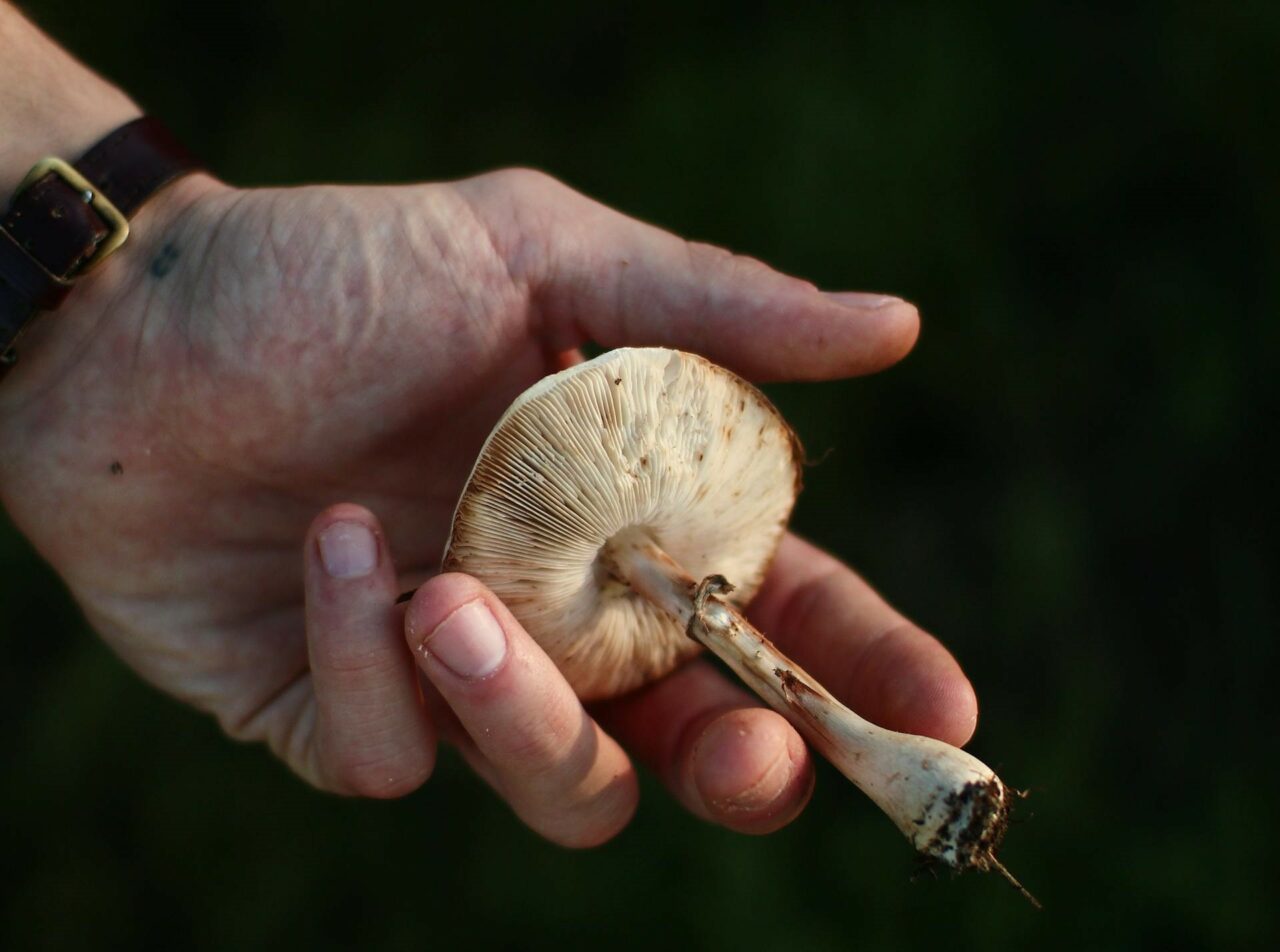Psilocybin mushrooms, a traditional psychedelic akin to LSD in their role as a serotonin 5-HT2A receptor agonist, are currently under investigation for their potential in psilocybin-assisted therapy. This therapy aims to address various mental health disorders, such as severe depression, anxiety, cluster headaches, and migraines.
To gain an understanding of how shrooms provide relief in these situations, it’s vital to delve into their metabolism within the body. This knowledge enables both researchers and users to comprehend how the active compound triggers psychological and therapeutic effects. This article offers a basic explanation of the pharmacology and pharmacokinetics of psilocybin.
[toc]
Key Takeaways:
- Upon oral consumption, half of the psychedelic fungi is absorbed and spread throughout the body.
- The compounds in the fungi undergo dephosphorylation via the enzyme alkaline phosphatase, mainly in the liver.
- Approximately 3.4% of the compound is expelled in its original form within 24 hours, with the rest being discharged as a stable metabolite.
What is Pharmacokinetics?
Pharmacokinetics (PK) refers to the study of how substances, such as drugs, are processed by the body once ingested. Although related, it’s different from pharmacodynamics, which delves into how a compound interacts with the body. PK focuses on four central aspects: absorption, distribution, metabolism, and excretion (ADME).
By understanding these processes, healthcare professionals can prescribe the most effective medications with the least risk. Moreover, it allows them to customize treatments based on each patient’s unique physiology and lifestyle.
How Does Pharmacokinetics Relate to Psilocybin?
Psilocybin and psilocin, the primary active components in some species of magic mushrooms, have piqued a great deal of interest among both researchers and users. Pharmacokinetics offers insights into how the body metabolizes these mushrooms, aiding our understanding of their potential medicinal or recreational effects.
These compounds are known by various names, including “magic,” “psychedelic,” “medicinal,” or “sacred.” The fungi that contain these compounds are ingested, with The Mushroom species, their origin, size, the conditions under which they’re grown and dried, and their age can all lead to significant differences in their concentrations.
These mushrooms naturally exist in the wild, but scientists have also developed lab-created versions. Both the wild and lab-grown mushrooms have low toxicity, although minor side effects such as nausea or vomiting may occur.
Despite these physical side effects, the compounds in these mushrooms have demonstrated potential therapeutic benefits due to their safety and non-addictive properties. This has prompted researchers to explore their use in psychotherapy, particularly as a treatment for anxiety and depression.
The 4 Stages of Pharmacokinetics
Psilocybin, the compound present in these mushrooms, is inactive in its unaltered state and functions as a prodrug, converting into its active form, psilocin. Enzymes such as alkaline phosphatase facilitate this conversion, enabling psilocin to be absorbed and distributed throughout the body, reaching various tissues. However, after oral intake, psilocybin cannot be detected in the circulatory system, feces, or urine.
Absorption
Absorption is the process by which the compound enters the bloodstream from the site of administration. It determines the rate and effectiveness with which the compound reaches its target, such as the plasma. The oral method is the most common route of administration. Inhalation has also been tried, but it is less effective than oral ingestion.
The absorption process also includes the release of the compound from the dosage form during oral intake. Factors such as a delay in the throat or esophagus can affect this, potentially slowing down the effects or causing discomfort. Once the compound reaches the stomach, the acidic environment may begin to decompose it before it enters the bloodstream.
Research on animals suggests that only about 50% of psychedelics administered orally get absorbed and spread throughout the body.
Factors Affecting the Absorption Process
Several factors can influence the absorption process, leading to variations in the onset, intensity, and duration:
- Stomach Contents: A full stomach can slow down the process because it delays the onset of effects. Conversely, an empty stomach allows for quicker absorption.
- Body Fat: Substances may accumulate in fat tissues, potentially prolonging their effects.
- Age: Metabolic rates and body composition often vary with age.
- Zero-Order Kinetics: The substance is expelled at a constant rate, regardless of its concentration.
- First-Order Kinetics: The elimination rate is directly related to the concentration of the substance.
The term dispersion is used to describe the process by which psilocin is disseminated throughout the body once it enters the bloodstream. Psilocin, being lipophilic, is capable of crossing the blood-brain barrier to access the central nervous system.
Various factors including the size, polarity, and protein-binding potential of the substance, as well as individual physiological aspects—such as hydration status and body composition—significantly impact this process.
The goal is to achieve an effective concentration at the target location. To be successful, the substance must reach the intended site, as defined by the volume of dispersion, and remain unbound to proteins, facilitating active interaction with its receptor.
What Factors Affect the Dispersion Process?
Several factors can influence the dispersion process:
Typically, the effects start to manifest within 20-40 minutes after consumption, peaking around 80-100 minutes. The effects of magic mushrooms generally last between 4-6 hours.
How Does Dispersion to the Brain Take Place?
An early experimental study on two species found that its binding affinity sequence is 5HT2A > 5HT1A > 5HT2B [23]. It also binds to dopamine D1, 5HT1E, 5HT5A, 5HT7, 5HT6, D3, 5HT2C, and 5HT1B receptors.
Acting as a partial agonist at the 5HT2A receptor, it shows about 40% efficacy. The psychedelic effects may be linked to its partial agonist activity at 5HT1A autoreceptors.
The mood-enhancing and psychotomimetic experiences might be associated with the noted correlation between increased dopamine levels and feelings of depersonalization and euphoria. Hallucinogens work by modifying neurochemistry and receptor activity. They enhance 5HT2A agonist activity by boosting BDNF synthesis in the hippocampus, which promotes neurogenesis and reduces conditioned fear-related behaviors.
Elimination
Elimination refers to the process by which the
The human body expels a substance mostly through the kidneys, but also via the lungs, skin, or gastrointestinal tract. In particular, the kidneys filter a naturally occurring psychedelic drug in the glomerulus or secrete it in the tubules. Some reabsorption occurs, making the elimination process more complex.
The primary substance has a half-life of roughly 160 minutes, while psilocin’s half-life is about 50 minutes. Animal research indicates that the substance is mainly excreted via urine, accounting for around 65% within 8 hours of consumption. Even after this period, the substance can be detected in smaller amounts in bile and feces.
In humans, approximately 3.4% of the substance is expelled unaltered within a day, while most is eliminated as psilocin-O-glucuronide, a more stable metabolite. This metabolite’s stability allows for the detection of the substance in urine samples over a longer duration.
Substances are primarily excreted through two methods:
Most psychedelic substances follow the first-order kinetics method, achieving steady-state concentrations after four to five half-lives. Complete elimination also typically occurs within four to five half-lives.
Discover Our Variety of Psychedelic Mushrooms
The metabolic process can differ between various types of fungi. By choosing reliable online providers like Mushroom Coffee Canada, you can avoid unintentionally ingesting poisonous mushrooms. Some varieties, like Agaric mushrooms, might cause intense and undesirable effects. Therefore, it’s essential to obtain magic mushrooms from trustworthy sources, rather than risky street dealers or wild foraging.
| Feature | Enigma | Full Moon Party | Gold Member | |
| Strain Type | Psilocybe Cubensis OMNI | Psilocybe cubensis (Thai Koh Samui) | Psilocybe cubensis | |
| Potency | Exceptionally high; 3.8% tryptamine content | Moderate to high potency | High potency | |
| Visual Characteristics | Resembles a blob or | Resembles a cauliflower or brain in structure | Displays typical cubensis features; moderately sized | Thick white stalks; caps of golden caramel; apparent blue bruising |
| Effects | Known as the most potent; generates intense effects | Potent mental high; delayed commencement with marked visuals | Powerful visuals and euphoria |
Discover Psilocybin Mushroom Use Online
It’s crucial for medical professionals, researchers, and users to understand the pharmacokinetics of shrooms. This knowledge allows you to make educated decisions about dosage and timing, thereby reducing potential risks.
Discover your perfect psychedelic experience at Mushroom Coffee Canada. Whether you desire a soothing journey or a deeper exploration, our wide variety of products is designed to meet your individual requirements. Enjoy high-quality, safe, and controlled shrooms, eliminating worries about dubious sources or poisonous mushrooms.
Experience the best magic mushrooms Canada has to offer and take your psychedelic journey to new heights.
Frequently Asked Questions
Are there any known interactions between shrooms and other drugs?
Our products may interact with specific medications, particularly those affecting serotonin levels, such as SSRIs (Selective Serotonin Reuptake Inhibitors). SSRIs and SNRIs (Serotonin and Norepinephrine Reuptake Inhibitors) are likely to lessen the effects, unlike non-serotonergic antidepressants. This reduced effect can last up to three months after stopping the antidepressant.
Do all psychedelics follow the same route as psilocybin?
No, each psychedelic substance has a unique structure that requires different metabolic processes to activate, and they bind to various receptors in the body. The method of administration also affects each psychedelic’s absorption. While the basic principles of absorption, metabolism, and distribution are the same, the specific pathways and effects vary for each substance.
Can the mushroom’s form affect the pharmacokinetics?
Yes, the form of the mushroom (whether fresh, powdered, or dried) can influence the absorption rate. For example, powdered forms may be absorbed quicker than whole dried ones due to faster dissolution.
Related Articles:





